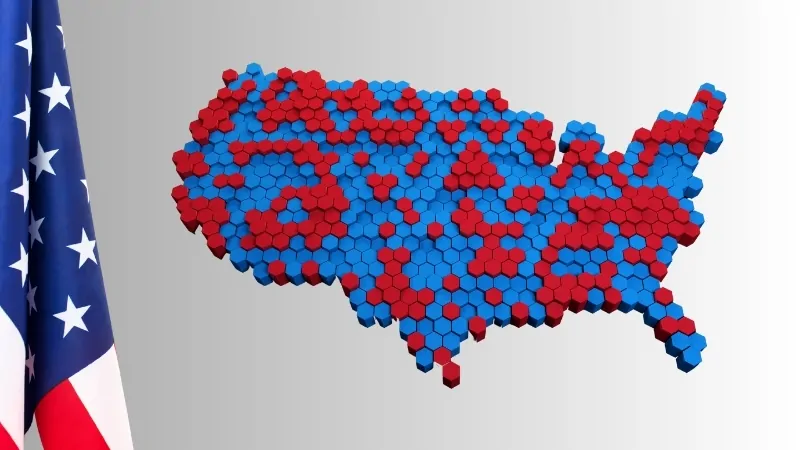As of 2025, the political landscape of the United States has shifted significantly: Republicans have regained control of the White House, the U.S. Senate, and narrowly held the U.S. House of Representatives, signaling a strong rightward movement compared to the previous Democratic victories in 2020.
According to Reuters, Donald Trump won 31 states—including key former Democratic strongholds like Arizona, Georgia, Michigan, Nevada, and Wisconsin—while Kamala Harris carried 19 states.
Despite the Republican sweep in terms of state count, many blue states remain more densely populated, meaning the Electoral College map often tells a different story than the national popular vote.
The 2024 presidential election marked a sharp reversal, with Donald Trump defeating Kamala Harris and winning both the popular vote and the Electoral College, becoming the first Republican to win the popular vote since 2004.
In Congress, Republicans expanded their Senate majority to 53 seats and held a narrow 220–215 majority in the House. At the state level, Republicans control 27 governorships, compared to 23 held by Democrats, further solidifying GOP power across much of the interior U.S.
Table of Contents
ToggleRed vs. Blue States: 2020 vs. 2024
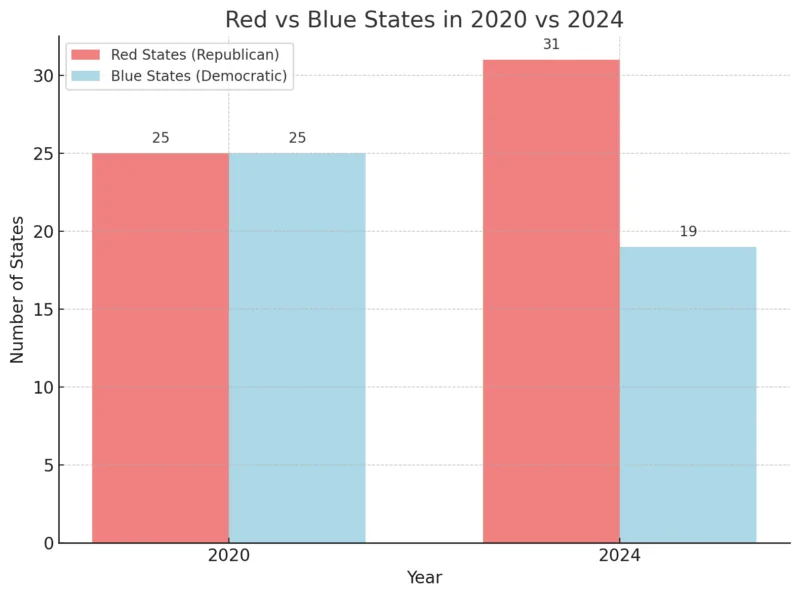
Between 2020 and 2024, the Republican map expanded significantly, reclaiming control of swing states and gaining ground in the Midwest, South, and Sun Belt.
Democrats retained strength in the West Coast (CA, WA, OR), Northeast (NY, MA, NJ), and urban metro centers, but lost ground in more moderate and rural-leaning regions, according to Brookings.
The 2024 presidential election highlighted both changing and persistent political divides in the U.S.
Economic & Policy Impact (2020–2024)
Between the 2020 and 2024 elections, the economic and political divide between red and blue states became more visible in terms of policy priorities, COVID recovery, and job growth.
Key Differences
Category
Blue States (2020–2024)
Red States (2020–2024)
COVID-19 Policy
Strict mandates, vaccine requirements (e.g., CA, NY)
Earlier reopenings, fewer mandates (e.g., FL, TX)
Unemployment Recovery
Slower reopening led to slower but steadier recovery
Quicker bounce-back, but some volatility
Tax & Business Policy
Increased regulation and taxation in many states
Corporate-friendly policies, low tax rates
Migration Trends
Outmigration from CA, NY to states like FL, TX, AZ, NC
In-migration led to economic booms in Sun Belt states
GDP Growth Trends
Strong in tech-heavy states like CA and WA
Surged in FL, TX, TN, driven by real estate and migration
Notable Outcomes
- Red states like Florida and Texas outpaced most blue states in post-pandemic job growth and domestic migration, attracting businesses and residents seeking lower costs of living and fewer regulations, as it was noted by WSJ.
- Blue states retained strength in education, healthcare access, and tech innovation, but faced political backlash over lockdowns and urban crime.
- This economic divide helped shift political sentiment in battleground states, aiding Trump’s performance in 2024.
2020 vs 2024 Presidential Elections
Election Year
Democrat Candidate
Republican Candidate
Electoral Votes (D-R)
Popular Vote Margin
Key State Flips
Winner
2020
Joe Biden
Donald Trump
306 – 232
Biden +7 million (4.5%)
Arizona, Georgia, Michigan, Pennsylvania, Wisconsin (to Biden)
Biden (D)
2024
Kamala Harris
Donald Trump
226 – 312
Trump +1.5%
Pennsylvania, Georgia, North Carolina, Michigan, Arizona, Wisconsin, Nevada (to Trump)
Trump (R)
In 2020, Democratic nominee Joe Biden defeated incumbent Republican Donald Trump, winning 306 electoral votes to Trump’s 232, according to APNEWS.
Biden carried 25 states plus Washington D.C., flipping several “red” states that Trump had won in 2016 – including Arizona, Georgia, Michigan, Pennsylvania, and Wisconsin. Nationally, Biden led the popular vote by about 7 million votes (a 4.5% margin).
This marked a shift in the electoral map as traditionally red-leaning states like Georgia and Arizona voted Democratic for the first time in decades. Biden’s victory gave Democrats control of the White House, ending the single-term Trump presidency.
BREAKING: Donald Trump wins Arizona. With the final state called in the presidential election, Trump won 312 electoral votes and Kamala Harris won 226 electoral votes. https://t.co/kStgXCQZnR pic.twitter.com/rwsLfyDtOp
— The Associated Press (@AP) November 10, 2024
In 2024, the pendulum swung back. Former President Donald Trump (seeking a non-consecutive second term) defeated Democratic candidate Kamala Harris (the incumbent Vice President). Trump won 312 electoral votes to Harris’s 226, flipping back six states that had gone blue in 2020.
Republicans carried all seven key battleground states – notably Pennsylvania, Georgia, North Carolina, Michigan, Arizona, Wisconsin, and Nevada – which together account for 93 electoral votes, as noted by aljazeera.com.
Trump also narrowly won the popular vote (about 49.8% to 48.2%, roughly a 1.5% margin) – making him the first Republican since 2004 to win the popular vote in a presidential race, according to Fox9.com.
U.S. Senate Elections (2020, 2022, 2024)
U.S. Senate party composition after the 2020, 2022, and 2024 elections. Democrats (blue) held 50 seats after 2020, 51 after 2022, but dropped to 47 after 2024; Republicans (red) went from 50 to 49 to 53.
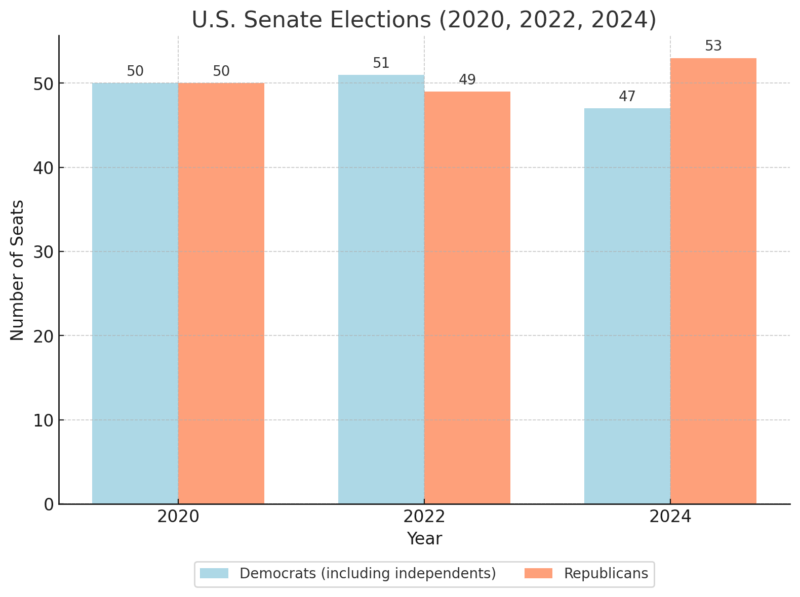
During the 2020 elections, Democrats achieved a net gain of three Senate seats, leading to a 50–50 split between the parties according to CNN. Despite the tie, Democrats took control of the chamber in 2021, as Vice President Kamala Harris provided the deciding vote.
This result was largely driven by Democratic victories in both of Georgia’s Senate runoff races, flipping a traditionally Republican stronghold and reshaping the Senate landscape.
In the 2022 midterms, Democrats defied historical precedent by expanding their majority. They flipped a Republican-held seat in Pennsylvania and successfully defended all their incumbent seats, ending with a 51–49 advantage.
This marked the first time since 1934 that a Democratic president’s party gained Senate seats in a midterm election. Key battlegrounds like Arizona, Nevada, and Georgia again leaned Democratic, as many voters rejected far-right Republican Senate candidates.
The 2024 elections, however, marked a dramatic Republican resurgence. The GOP flipped several Democratic-held seats, including critical wins in Arizona and Nevada, and captured an open seat in deep-blue California through a party switch by a moderate independent, as noted by NBC.
This net gain of four seats gave Republicans a 53–47 majority, shifting Senate control back to the GOP. Combined with Donald Trump’s presidential victory, Republicans secured a full government trifecta for the first time since 2016.
As of 2025, Senator Mitch McConnell has resumed his role as Majority Leader, overseeing a Republican-controlled Senate amid a political environment that favored red-state dominance.
Gubernatorial Elections (2020–2024): Red vs. Blue State Leadership in Transition
From 2020 to 2024, governors’ mansions across the country reflected the shifting balance of red and blue state control. While the presidential and congressional races saw dramatic swings during this period, the state-level gubernatorial landscape remained more stable, with limited partisan flips and a continuation of regional trends:
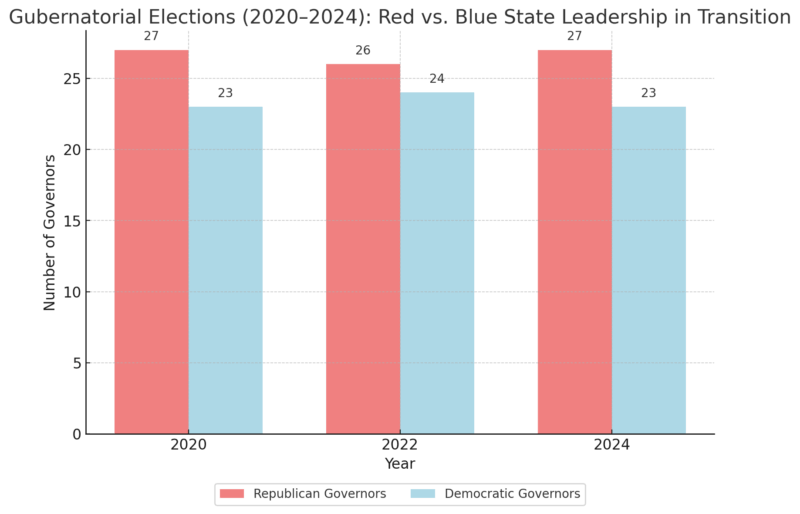
2020: Minimal Change, Reinforced Alignments
In the 2020 cycle, 11 states held gubernatorial elections. Only one state flipped:
This brought Republicans to 27 governors and Democrats to 23. The rest of the states either re-elected incumbents or chose successors from the same party, reinforcing existing political identities.
Notable Blue-Held States That Re-Elected Republican Governors:
Red-Held States That Cemented GOP Power:
2022: A Rare Midterm Upset for Democrats
The 2022 midterms brought one of the most surprising gubernatorial cycles in decades.
Out of 36 races, Democrats achieved a net gain of +2, defying historical trends where the president’s party typically loses ground, as noted by NBC.
Democratic Gains
- Arizona: Democrat Katie Hobbs won in a traditionally red-leaning swing state.
- Maryland: Wes Moore became the state’s first Black governor, flipping a Republican-held seat.
- Massachusetts: Maura Healey flipped this GOP-held governorship and became the state’s first female and openly gay governor.
Republican Gain
Final count post-2022: 26 GOP governors, 24 Democratic.
This was the first time since 1990 that a Democratic president’s party gained governorships in a midterm, according to 270toWin.
2024: All Status Quo, No Party Flips
In a rare instance of political stability, all 11 gubernatorial races in 2024 resulted in the same party retaining control.
Key Races
- North Carolina (DEM-held open seat): Democrat Josh Stein won, keeping the state blue despite Trump’s presidential win there.
- New Hampshire (GOP-held open seat): Republican Kelly Ayotte succeeded retiring Governor Chris Sununu, preserving GOP control.
Even in highly competitive states, incumbency and strong state-level candidates led to zero partisan flips.
- Republicans returned to 27 governors,
- Democrats are back to 23 — the same as in 2020.
Geographic Overview: Red vs. Blue State Leadership

Republican Strongholds (2025)
Region
Key Red-Governed States
South
Florida, Texas, Georgia, Tennessee
Midwest
Ohio, Iowa, Indiana
Mountain West
Utah, Montana, Wyoming, Idaho
Democratic Strongholds (2025)
Region
Key Blue-Governed States
West Coast
California, Oregon, Washington
Northeast
New York, Massachusetts, New Jersey
Inner Blue
Colorado, Illinois, Minnesota
Crossover States:
- Vermont (R governor, blue state)
- Kansas & Kentucky (D governors, red states)
Political Impact: Policy and Voter Behavior
The makeup of governors post-2024 continues to shape the policy divide between red and blue states:
Policy Area
Republican Governors
Democratic Governors
Taxes
Focus on cuts, low corporate tax states
Progressive tax pushes in blue states
Abortion Laws
More restrictions post-Roe v. Wade
Codified or expanded abortion access
Gun Laws
Expanded rights, constitutional carry
More regulation and waiting periods
Climate & Energy
Fossil fuel protection, energy independence
Clean energy incentives, regulations
Education
Parental rights, limits on curriculum
DEI expansion, teacher union support
U.S. House Elections (2020, 2022, 2024)
The U.S. House of Representatives experienced modest but impactful partisan shifts over the last three election cycles, with narrow margins that reflected the deeply divided political landscape.
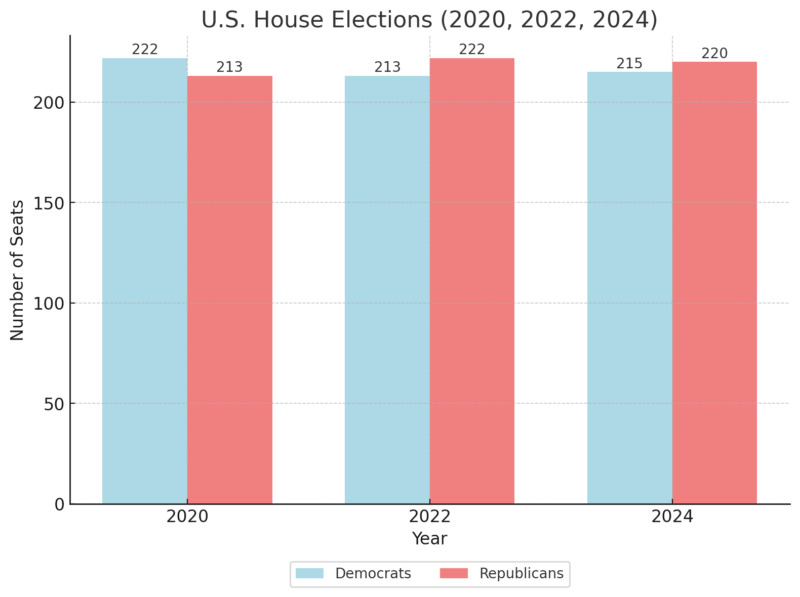
In 2020, Democrats retained control of the House with 222 seats, down from their large majority won in 2018. Republicans made significant inroads by flipping 13 seats, cutting into Democratic gains from the previous cycle.
The final makeup of the chamber was 222 Democrats to 213 Republicans, and despite these GOP gains, Speaker Nancy Pelosi continued to lead a slim Democratic majority.
These results illustrated that while Joe Biden won the presidency, House districts — especially in more conservative or swing areas — remained competitive or leaned Republican.
The 2022 midterms were expected to deliver a “red wave,” but the results proved far more muted, as noted by Politico. Republicans succeeded in flipping the House, but with a narrow 222–213 majority — the same seat split Democrats had two years earlier, only now reversed.
Key GOP overperformances in states like New York and Florida helped tip the balance. However, Democrats also overperformed in other regions, which kept the outcome surprisingly close.
With a four-seat majority, Kevin McCarthy was elected Speaker, marking the return of divided government in Washington. This election also made history, as it was the first midterm since 1954 in which a president’s party gained Senate seats while simultaneously losing the House.
In 2024, the battle for the House remained extremely tight. Democrats made minor gains, flipping a few suburban and competitive districts — particularly in New York and Arizona — but Republicans held on to control with 220 seats to Democrats’ 215, according to CFP.
This razor-thin majority — just two seats above the minimum needed to govern — has left Republicans with limited room for internal dissent. The national House popular vote in 2024 showed a slight Republican edge at +2.6%, suggesting a small but persistent rightward lean in congressional races, even as the presidential race generated intense Democratic turnout in key states.
As of 2025, the Republican-controlled House faces the challenge of governing with a slim and potentially unstable majority, giving leverage to moderate Republicans and swing-district lawmakers. Meanwhile, Democrats are regrouping, aiming to retake control in the 2026 midterms, which historically favor the party out of power.
2020 Election Fraud Allegations: Findings, Impact, and Political Fallout
Following the 2020 presidential election, the United States entered a turbulent period of political controversy as then-President Donald Trump and several allies claimed the election had been stolen through widespread voter fraud.
These allegations, which gained significant traction in conservative media and among parts of the electorate, were extensively investigated by federal agencies, state officials, bipartisan election boards, and the judiciary.
The overwhelming conclusion from more than 60 court cases, audits, and recounts was clear: there was no credible evidence of widespread fraud that could have altered the outcome of the election.
However, despite the legal and factual clarity, the political and geographic ramifications were profound. Public trust in election integrity became sharply divided along party lines, and the red vs. blue state divide deepened in both perception and policy behavior between 2020 and 2024.
Date
Event
Outcome
Nov 3, 2020
U.S. Presidential Election Day
Joe Biden wins 306–232 in the Electoral College, +7M in popular vote
Nov 12, 2020
DHS Cybersecurity & Infrastructure Security Agency statement
“Most secure election in American history”; no evidence of vote manipulation
Dec 2020–Jan 2021
Over 60 lawsuits have been filed in state and federal courts challenging the results
All major lawsuits dismissed or ruled against Trump campaign; no fraud found
Dec 7, 2020
Georgia completes hand recount
Original results confirmed; Biden wins by ~12,000 votes
July 2021
Arizona audit of Maricopa County ballots (GOP-led)
Biden still wins; audit shows no significant fraud, with Biden gaining ~360 votes in final tally
Jan 6, 2021
Congressional certification of electoral votes disrupted by Capitol riot
Congress reconvenes; Biden’s victory officially certified
Investigations and Legal Challenges: No Fraud Found
Every major credible investigation into the 2020 election found no evidence of widespread voter fraud:
- The Cybersecurity and Infrastructure Security Agency (CISA) stated the 2020 vote was the most secure in U.S. history, and there was “no evidence any voting system was compromised.”
- Attorney General William Barr, appointed by Trump, said: “To date, we have not seen fraud on a scale that could have affected a different outcome in the election.” according to CBS.
- More than 60 lawsuits filed across swing states were dismissed, many by Republican-appointed judges, as noted by Brookings.
- Recounts and audits in Georgia, Arizona, Michigan, Wisconsin, and Pennsylvania reaffirmed Biden’s wins in those states. Even in Arizona, where a controversial GOP-backed audit took place, the results showed Biden gained votes.
The Political Fallout: Misinformation and the Red–Blue Divide
Despite the facts, the fraud narrative took deep root in many Republican-majority states. According to a 2021 CNN poll, over 60% of Republicans believed the 2020 election had been stolen. This mistrust fueled partisan divides between red and blue states, especially on issues like election laws, voter ID, ballot access, and mail-in voting.
Red States
- Passed more restrictive voting laws post-2020 (e.g., Georgia, Texas, Florida).
- Emphasized voter ID, in-person voting, and limits on mail-in ballots.
- Republican governors and legislatures leaned into “election integrity” as a rallying policy issue.
Blue States
- Expanded access to vote-by-mail, early voting, and automatic registration (e.g., California, New York).
- Framed the push as protecting democracy and increasing accessibility.
- Blue state leaders publicly rejected fraud narratives and emphasized public trust.
This policy divergence intensified the geopolitical split: red states centralized and restricted election processes under the banner of security, while blue states expanded and decentralized access under the banner of inclusion.
Electoral Impact: 2020 → 2024 Shifts

By 2024, the legacy of 2020 fraud allegations reshaped the political map:
- Republicans reclaimed 7 battleground states: Georgia, Arizona, Pennsylvania, Michigan, North Carolina, Wisconsin, and Nevada, according to the BBC.
- Voter turnout and GOP enthusiasm surged in conservative states where fraud narratives were most amplified.
- Trust in elections became a predictor of party loyalty, reinforcing red vs. blue divisions at both the state and federal levels.
Impact of 2020 Allegations on 2024 Red-Blue State Outcomes
State
2020 Winner
2024 Winner
Post-2020 Legislative Action
Voter Trust Impact
Georgia
Biden (D)
Trump (R)
Voter ID laws; limited ballot drop boxes
GOP base energized; Dem turnout dropped
Arizona
Biden (D)
Trump (R)
Controversial audit; no fraud found
Moderate voters swung GOP
Pennsylvania
Biden (D)
Trump (R)
Mail-in voting restrictions proposed
Polarized urban vs rural
Wisconsin
Biden (D)
Trump (R)
GOP legislature pushed tighter laws
High GOP mobilization
Nevada
Biden (D)
Trump (R)
Mixed response; GOP surged in rural vote
Shifted red
Conclusion

As of 2025, the red vs. blue state divide has not only solidified—it has sharpened, with clear consequences for America’s political future. Over the course of three critical election cycles—2020, 2022, and 2024—the country experienced a rare back-and-forth in party control, culminating in a Republican resurgence that now controls the presidency, Senate, House, and the majority of governorships.
This shift didn’t happen in a vacuum. It was shaped by deeply divergent responses to the COVID-19 pandemic, state-level policy decisions on taxation, education, and voting rights, and—perhaps most importantly—the lingering effects of the 2020 election fraud narrative.
Although every credible investigation confirmed that the 2020 election was secure and legitimate, the rhetoric of a “stolen election” polarized voters, fueled GOP turnout, and led to restrictive voting laws in red states while blue states went the other direction—expanding access.
By 2024, Republicans had reclaimed 7 battleground states, flipped the U.S. Senate, and returned Donald Trump to the White House in a dramatic electoral reversal. Meanwhile, Democrats maintained strongholds in the Northeast, West Coast, and major urban centers but struggled to hold their ground in the Midwest, Rust Belt, and South—regions critical to electoral math.
At the state level, the split is stark: 27 Republican governors vs. 23 Democrats, with policies diverging dramatically across party lines on everything from gun laws to climate strategy. The U.S. House remains tightly contested, suggesting that even in the midst of Republican momentum, the electorate remains closely divided.


